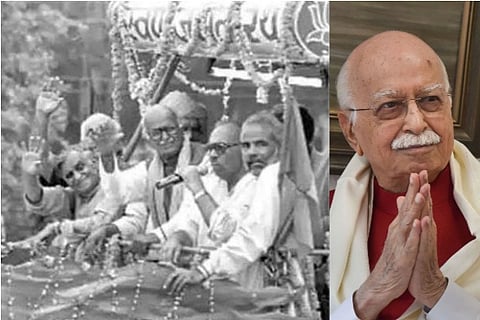

New Delhi
Former deputy prime minister, BJP patriarch and, above all, a key architect of the Ram temple whose ‘rath yatra’ gave fillip and form to the Ram Janmabhoomi movement, L K Advani won’t keep his date with history on Wednesday.
The 95-year-old, who in 1990 charioted the ‘Ram rath’ that made him the face of Hindutva politics and was instrumental in consolidating support for the BJP, said in his autobiography that the temple is a symbol of the "struggle between genuine secularism and pseudo-secularism".
Advani won’t be in Ayodhya for the ‘bhumi poojan’ of the temple because of his age.
In his 2008 autobiography “My Country, My Life”, he expressed the hope that it would write a new chapter in national integration.
In his book, he linked the Ram temple – being built where a large section of devout Hindus believes is where Ram was born – to the Somnath temple in Gujarat where he started his ‘rath yatra’ from.
The Somnath temple, which was looted and destroyed several times before being reconstructed under the supervision of Sardar Patel in 1951, was a testimony of India''s determination to erase the history of bigoted alien attacks and regain its lost cultural treasure, Advani said in his book.
In September of 1990, Advani, then the BJP president, started the ‘rath yatra’ that led his party to political power and forever changed its fortunes, from Somnath. Accompanying him on the journey was Narendra Modi, now prime minister.
Advani described the ‘rath yatra’ as the most "decisive transformational" event of his political journey. It catapulted him to dizzying political heights.
The plan was to end the ‘yatra’ in Ayodhya after passing through Gujarat, Maharashtra, Madhya Pradesh, Bihar and Uttar Pradesh. But it ended prematurely at Samastipur in Bihar on October 23, 1990 with Advani’s arrest.
He was arrested on the orders of then Bihar chief minister and Janta Dal leader Lalu Prasad Yadav and kept in detention at an irrigation department bungalow in Massanjore near Dumka, which is now in Jharkhand.
Slogans of “Jai Shri Ram”, “Saugandh Ram ki Khate Hain Mandir Wahin Banayenge” and “Jo Hindu Hit Ki Baat Karega Wahi Desh Pe Raj Karega” followed the ‘yatra’ wherever it passed, leading to communal polarisation and tension, and riots in some places.
Advani countered the reports, writing in his book that the recurring theme in his speeches was of a positive approach to religious faith and “Ram bhakti se lok shakti jagrut ho sakti hai (worship of Ram can awaken the strength of people).
Underlining that the Ayodhya movement was the continuation of the spirit of Somnath, Advani wrote that it is important to know the history of the Somnath temple to understand the movement for a Ram temple. The Somnath temple, he said, stands as a sobering reminder that a weak nation that cannot defend itself against external attacks stands to lose its cultural heritage also besides political freedom.
Crediting Sardar Patel, Mahatma Gandhi and others for its reconstruction, he said, "… it is a proud testimony of India''s determination to erase the history of bigoted alien attacks and regain its lost cultural treasure."
Everything the leaders did in realising the dream of the Somnath temple “echoed loudly” in his mind when the Ayodhya issue became centrestage of national politics.
Suggesting that fragmented votes of Hindus and the consolidated votes of Muslims created a “pernicious dynamic” in Indian politics in 1990s, Advani said because of this many political parties didn''t support the temple issue and "justified it in the name of secularism".
"Thus, the Ayodhya issue no longer remained limited to construction of the Ramjanambhoomi temple. Rather, it became the symbol of a struggle between genuine secularism and pseudo-secularism," Advani wrote.
Stating that the debate around the temple issue presented two opposite conceptions about India''s nationhood, Advani said these were the unifying concepts of cultural nationalism and dividing concept of anti-Hindu nationalism.
"It was in this context that the BJP decided to support the Ramjanambhoomi movement," he said.
In 1989, the BJP hitched its bandwagon to the Ram temple issue by passing for the first time a resolution supporting the construction of a Ram temple in its national executive meeting in Palampur in Himachal Pradesh.
In his conclusion to the Ayodhya chapter in the book, Advani expressed the hope that the Ayodhya mission would be completed through the joint efforts of Hindus and Muslims and it will write "a new chapter in mutual reconciliation and national integration”.
On December 6, 1992, the 16th century Mughal era Babri Masjid, which a section of Hindus believed was built at the spot where Ram was born, was demolished.
Advani, who was present in Ayodhya, described it as the "saddest day" of his life.
While Advani strongly defends the Ram Janambhoomi movement for the construction of temple and the participation of the BJP in his book, he also expresses his feelings on the "ill-fated culmination" of the movement.
Advani is facing a trial in the Babri Masjid demolition case.
Riding on the success of the ''yatra'', the BJP become a second pole in Indian politics along with the Congress. And Advani was pushed to forefront, going on to become deputy prime minister during the BJP-led NDA government from 1999 to 2004. The ‘yatra’ not only made Advani the face of Hindutva politics but also the ‘hardline’ BJP leader compared to Atal Bihari Vajpayee who was seen as a liberal.
Visit news.dtnext.in to explore our interactive epaper!
Download the DT Next app for more exciting features!
Click here for iOS
Click here for Android